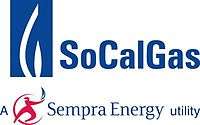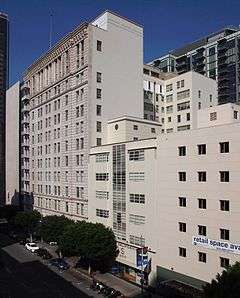Southern California Gas Company
 | |
| Subsidiary | |
| Industry | Utilities |
| Founded | 1867 |
| Headquarters | Los Angeles, California, United States |
Key people | Dennis Arriola, President and CEO |
| Products | Natural Gas |
| Parent | Sempra Energy |
| Website | http://www.socalgas.com/ |
The Southern California Gas Company (referred to as SoCalGas) is the primary provider of natural gas to the region of Southern California. Its headquarters are located in the Gas Company Tower in Downtown Los Angeles.[1]
Service Territory
SoCalGas provides natural gas service for approximately 21.4 million customers, spanning roughly 20,000 square miles of California, extending from Visalia in the north to the Mexican border in the south.[2] Gas service for San Diego County is provided by sister utility San Diego Gas & Electric, and Southwest Gas and the Long Beach Gas & Oil Department (LBGO) carve out small portions of the Southern California area for natural gas delivery.
The company provides gas service for all or part of the following counties:
- Imperial
- Kern
- Kings
- Los Angeles
- Orange
- Riverside
- San Bernardino
- San Luis Obispo
- Santa Barbara
- Tulare
- Ventura
Electric service for Southern California is generally provided by Southern California Edison. The northern portion of the state is generally provided service by Pacific Gas & Electric Company.
History

This gas company's roots trace back to the 1800s when new settlers arrived in Los Angeles in search of a new frontier. In 1867, Los Angeles Gas Company, the forerunner of today's Southern California Gas Company, installed 43 new gas lamps along Main Street, making the city safer at night. The gas lighting business was run by five entrepreneurs who manufactured the gas from asphalt, a tar-like substance, and later from oil.
The company was enjoying modest success until Thomas Edison introduced his electric light in 1879. With the future of the gas lamp business uncertain, the company began looking for other uses for gas, and Los Angeles soon had its first gas stove and heater. Meanwhile, Pacific Enterprises was looking to expand its gas business. Founded in San Francisco in 1886 as Pacific Lighting, the company bought several small gas manufacturing and distribution companies in the area, including the Los Angeles Gas Company in 1890. These companies ultimately became Southern California Gas Company.
By the early 20th century, natural gas—a colorless, odorless gas found in association with oil underground—was starting to gain attention. The breakthrough came with the discovery of the Buena Vista Oil Field near Taft, California in 1909, which included a huge reservoir of natural gas. Since natural gas had twice the heating value of manufactured gas, the company took the bold step to convert its system to natural gas and build pipelines throughout the state. Natural gas was soon found throughout the country, and demand for the fuel was rapidly growing. To meet customer demand, the company began storing gas in large holding tanks. In 1941, the company introduced a new system to the Southwest United States: underground storage of natural gas. By 2016, the company had four separate underground storage facilities, all of them depleted oil and gas fields repurposed as gas storage. The four are, in order from largest to smallest, the Aliso Canyon field, north of Porter Ranch; Honor Rancho, near Newhall; the La Goleta Gas Field adjacent to Goleta; and the Playa del Rey storage facility, north of Playa del Rey, near the Los Angeles International Airport.[3]
As Southern California's population grew, so too, did the company, eventually becoming the nation's largest natural gas distribution utility, serving 19.5 million people through 5.5 million gas meters in more than 530 communities. Headquartered in Los Angeles, Southern California Gas Company is a subsidiary of Sempra Energy, a Fortune 500 company based in San Diego. Its service area encompasses 23,000 sq mi (60,000 km²) of diverse terrain throughout most of Central and Southern California, from just south of Sanger to the Mexican border.
In late 2012, the company began the Advanced Meter Installation Project that consists of upgrading over 6 million gas meters with the new Advanced Meter communication device. This device is attached to an analog gas meter that automatically and securely transfers gas usage information to the company’s customer service and billing centers. The California Public Utilities Commission (CPUC) has approved a budget of $1.05 billion for this project, which is expected to be completed in 2017.
Environmental impact
A gas leak from the underground Aliso Canyon gas storage started in October 2015 releasing methane in an uncontrolled fashion. By December 2015, thousands of people from Porter Ranch had been temporarily relocated and the leak had added more than 150 million pounds of methane to the atmosphere.[4][5] The NGO Environmental Defense Fund has called the incident "unprecedented for California" and compared the leak's continuous output of greenhouse gas emissions to that of 7 million cars or "8 or 9 coal-fired plants".[6] The incident has been called "the biggest environmental disaster since the Deepwater Horizon oil spill" by journalists.[7]
References
- ↑ Sanchez, Jesus. "They Got a Ticket to Deride Many Commuters Say They Can't Afford Metrolink's Pricey Fares." Los Angeles Times. October 22, 1992. Business Part D Financial Desk 1. Retrieved on April 7, 2010. "At Southern California Gas Co. headquarters in downtown Los Angeles,"
- ↑ SoCalGas Company Profile
- ↑ Public Utilities Commission of California (November 2014). "Direct testimony of Phillip E. Baker" (PDF). Southern California Gas Company. pp. 2–4. Retrieved January 9, 2016.
- ↑ Abram S (December 19, 2015). "Two months in, Porter Ranch gas leak compared to BP Gulf oil spill". Los Angeles Daily News. Retrieved December 27, 2015.
- ↑ Joby Warrick (December 24, 2015). "New Infrared Video Reveals Growing Environmental Disaster in L.A. Gas Leak". The Washington Post. Retrieved December 29, 2015.
- ↑ Andrew Freedman (December 24, 2015). "'Unprecedented' gas leak in California is the climate disaster version of BP's oil spill". Mashable. Retrieved December 31, 2015.
- ↑ Alissa Walker (December 28, 2015). "A California Gas Leak Is the Biggest Environmental Disaster Since the BP Oil Spill". Gizmodo. Retrieved December 31, 2015.
External links
- SoCalGas.com: official Southern California Gas Company website
- SoCalGas.com: official Aliso Canyon gas leak website
- Sempra Energy website